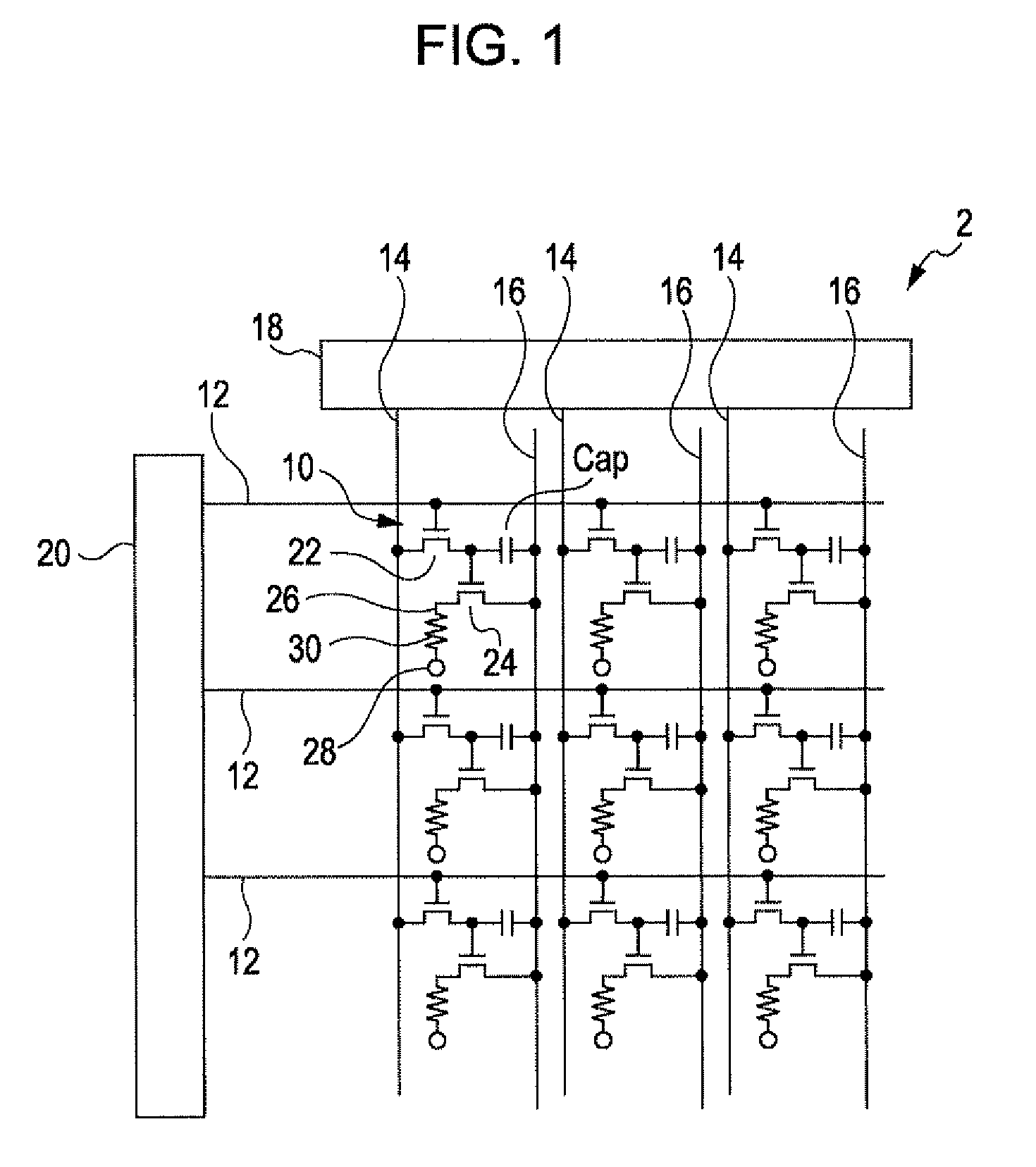Organic electroluminescent apparatus
- Summary
- Abstract
- Description
- Claims
- Application Information
AI Technical Summary
Benefits of technology
Problems solved by technology
Method used
Image
Examples
first embodiment
[0039]FIG. 1 is a circuit diagram of a matrix of pixel regions that constitute an organic EL light-emitting apparatus 2 according to a first embodiment. FIG. 2 is a plan view of a pixel 10 of the organic EL light-emitting apparatus 2. FIG. 3A is a plan view of the organic EL light-emitting apparatus 2. FIG. 3B is a cross-sectional view of the organic EL light-emitting apparatus 2 taken along the line IIIB-IIIB in FIG. 3A. In FIG. 3A, for the sake of clarity, a second substrate is eliminated.
[0040]As illustrated in FIG. 1, the organic EL light-emitting apparatus 2 includes a plurality of scanning lines 12, a plurality of signal lines 14, which intersect the scanning lines 12, a plurality of common feeders 16 parallel to the signal lines 14, and pixels 10 at the points of intersection of the scanning lines 12 and the signal lines 14.
[0041]The signal lines 14 are connected to a data drive circuit 18, which includes a shift register, a level shifter, a video line, and an analog switch. ...
second embodiment
[0114]A second embodiment will be described below with reference to the drawings.
[0115]FIG. 5A is a plan view of an organic EL light-emitting apparatus 4 according to the second embodiment. FIG. 5B is a cross-sectional view of the organic EL light-emitting apparatus 4 taken along the line VB-VB in FIG. 5A. The organic EL light-emitting apparatus 4 has the same basic structure as the organic EL light-emitting apparatus 2 according to the first embodiment, except that a counter substrate 56 has a depression (recessed portion) 74, and that the thickness a of a first sealing portion 54 is different from the thickness b of a second sealing portion 50. Thus, the same components used in the present embodiment as in the first embodiment are denoted by the same reference numerals and will not be further described.
[0116]As illustrated in FIG. 5, the organic EL light-emitting apparatus 4 according to the present embodiment has the depression 74 in the counter substrate 56 corresponding to a re...
third embodiment
[0118]A third embodiment will be described below with reference to the drawings.
[0119]FIG. 6A is a plan view of an organic EL light-emitting apparatus 6 according to the third embodiment. FIG. 6B is a cross-sectional view of the organic EL light-emitting apparatus 6 taken along the line VIB-VIB in FIG. 6A. In FIG. 6A, for the sake of clarity, a counter substrate is eliminated. The organic EL light-emitting apparatus 6 has the same basic structure as the organic EL light-emitting apparatus 2 according to the first embodiment, except that a first sealing portion 54 is in contact with a second sealing portion 50. Thus, the same components used in the present embodiment as in the first embodiment are denoted by the same reference numerals and will not be further described.
[0120]In the organic EL light-emitting apparatus 6 according to the present embodiment, as illustrated in FIG. 6, a sealant 68 applied to a region 64 in which a first sealing portion is to be formed is in contact with ...
PUM
 Login to View More
Login to View More Abstract
Description
Claims
Application Information
 Login to View More
Login to View More - R&D
- Intellectual Property
- Life Sciences
- Materials
- Tech Scout
- Unparalleled Data Quality
- Higher Quality Content
- 60% Fewer Hallucinations
Browse by: Latest US Patents, China's latest patents, Technical Efficacy Thesaurus, Application Domain, Technology Topic, Popular Technical Reports.
© 2025 PatSnap. All rights reserved.Legal|Privacy policy|Modern Slavery Act Transparency Statement|Sitemap|About US| Contact US: help@patsnap.com



